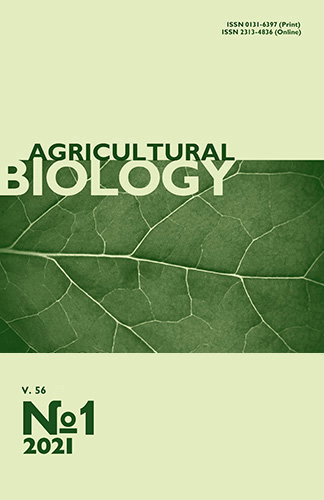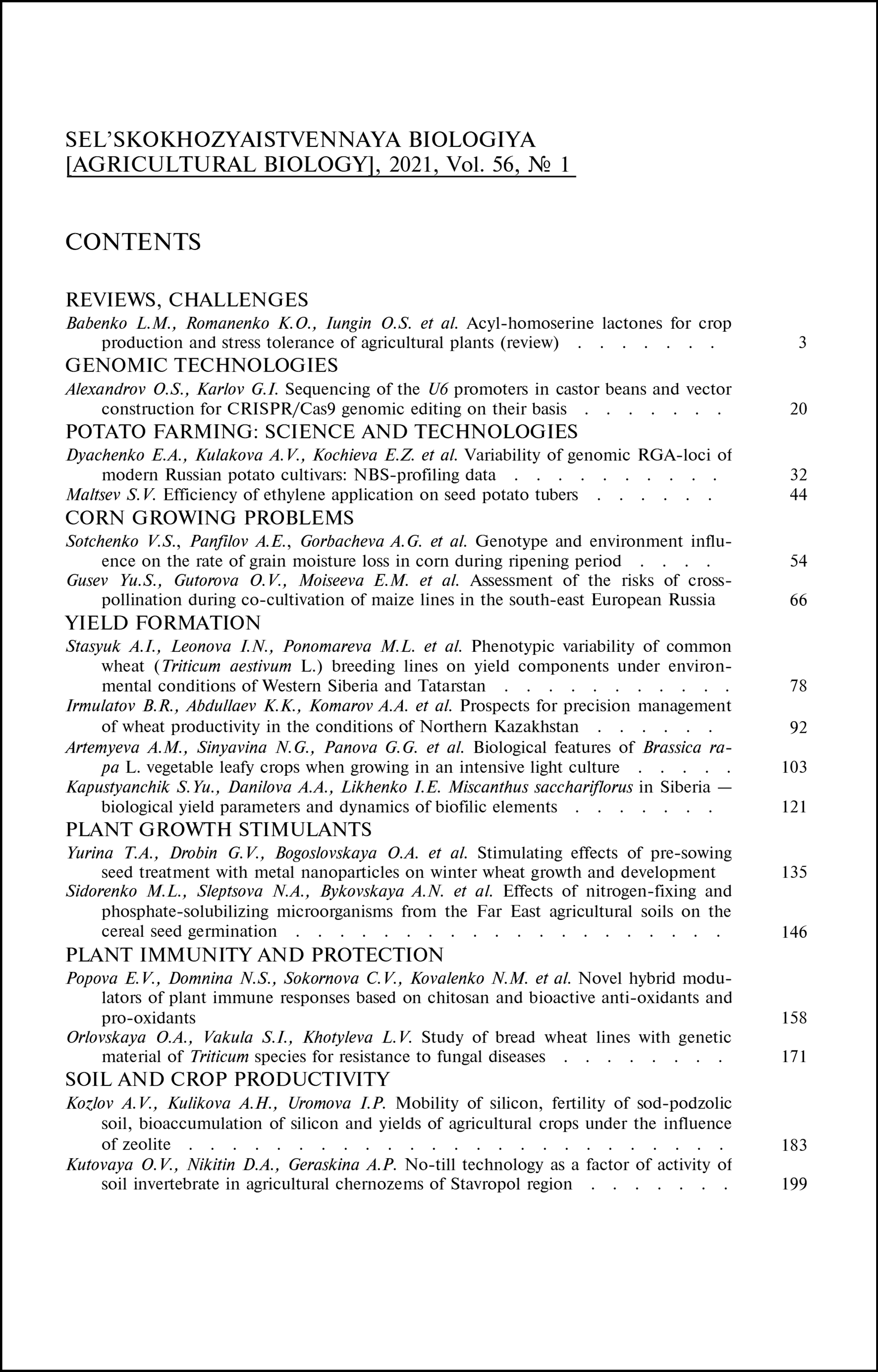doi: 10.15389/agrobiology.2021.1.158eng
UDC: 633.11:632.959
NOVEL HYBRID MODULATORS OF PLANT IMMUNE RESPONSES BASED ON CHITOSAN AND BIOACTIVE ANTI-OXIDANTS AND PRO-OXIDANTS
E.V. Popova ✉, N.S. Domnina, C.V. Sokornova, N.M. Kovalenko, S.L. Tyuterev
All-Russian Research Institute of Plant Protection, 3, sh. Podbel’skogo, St. Petersburg, 196608 Russia, e-mail elzavpopova@mail.ru (✉ corresponding author), ninadomnina@mail.ru, mymryk@gmail.com, nadyakov@mail.ru, mail@vizr.spb.ru
ORCID:
Popova E.V. orcid.org/0000-0003-3165-6777
Kovalenko N.M. orcid.org/0000-0001-9577-8816
Domnina N.S. orcid.org/0000-0002-7124-899Х
Tyuterev S.L. orcid.org/0000-0003-2397-9656
Sokornova C.V. orcid.org/0000-0001-6718-4818
Received February 19, 2020
During the infection of plants with pathogens, the equilibrium between oxidative processes and antioxidant activity shifts toward an increase in the formation of ROS, which affects the course of the development of the disease and manifests itself differently in phytopathosystems of various types of parasitism. So, to protect plants from biotrophic pathogens, ROS generation is necessary, but the resulting high level of ROS does not protect, but, on the contrary, favors the pathological process caused by necrotrophs. Substances that can control not only ROS generation, but also their utilization, can become effective immunomodulators to protect plants when infected with pathogens of different lifestyles. For the first time, chitosan-based hybrid immunomodulators (Chit-Van+SA) were created, in the structure of which there are fragments of biologically active substances that have antioxidant and prooxidant effects. The basis of such systems is chitosan (Chit), containing covalently attached vanillin (Chit-Van), which reduces the ROS level by stimulating cellular antioxidant activity (antioxidant effect), and salicylic acid (Chit+SA), which is associated with a labile ionic bond, generating ROS (prooxidant act). It was shown that (Chit+SA) increases the wheat resistance to Puccinia recondita Roberge ex Desmaz f. sp. tritici biotroph and Cochliobolus sativus Drechs hemibiotroph, while (Chit-Van) effectively induces resistance only to C. sativus hemibiotroph. The effectiveness (Chit+CA) as an inducer of stability is 1.2-2.0 times higher than the inducing effect of chitosan itself (Chit). It was found that hybrid immunomodulators (Chit-Van+SA) with respect to both the biotroph (brown rust) and the hemibiotroph (dark brown spotting) with a molar ratio of vanillin and salicylic acid in them in the range 1:1-1:2 show a high immunomodulating activity, regardless of the molecular weight of chitosan, which is expressed in a decrease in the area of leaf damage to 5-10 % of the control. The results obtained indicate that the biological effectiveness of the hybrid polymer system (Chit-Van+SA) as an immunomodulator correlates with the content of SA in them, which confirms the participation of the signal salicylate system in the induction of resistance. It is established that specific enzymatic antioxidants superoxide dismutase, catalase and peroxidase, which regulate the relationship between oxidative processes and antioxidant activity, play an important role in the development of induced resistance when using the created immunoinductors. In general, the results of studying the effect of the hybrid immunomodulators (Chit-Van+SA) on the activity of antioxidant enzymes in the model system wheat—C. sativus suggest that the increase in plant resistance to pathogens is realized through the control of the intensity of redox processes in plants, which is caused by the presence in the structure of hybrid immunomodulators of a certain pro- and antioxidant balance.
Keywords: Puccinia recondita, Cochliobolus sativus, chitosan, induced resistance, salicylic acid, vanillin, wheat, dark brown spotting, brown rust.
REFERENCES
- Gul'tyaeva E.I., Shaidayuk E.L., Shipilova N.P., Levitin M.M., Kolesnikova O.A., Maslova I.V., Vusatyuk M.P. Zashchita i karantin rastenii, 2016, 4: 29-31 (in Russ.).
- Sanin S.S., Nazarova L.N. Zashchita i karantin rastenii, 2010, 2: 20-26 (in Russ.).
- Grishechkina L.D., Dolzhenko V.I. Agrokhimiya, 2013, 2: 28-33 (in Russ.).
- Tyuterev S.L. Prirodnye i sinteticheskie induktory ustoichivosti rastenii k boleznyam [Natural and synthetic inducers of plant resistance to diseases]. St. Petersburg, 2014 (in Russ.).
- Gozzo F., Faoro F. Systemic acquired resistance (50 years after discovery): moving from the lab to the field. J. Agric. Food Chem., 2013, 61(51): 12473-12491 CrossRef
- Thakur M., Sohal B.S. Role of Elicitors in inducing resistance in plants against pathogen infection: a review. International Scholarly Research Notices, 2013, 2013: Article ID 762412, CrossRef
- Pieterse C.M., Van Does D., Zamioudis C., Leon-Reyes A., Van Wees S.C. Hormonal modulation of plant immunity. Annual Review of Cell and Developmental Biology, 2012, 28(1): 489-521 CrossRef
- Spoel S.H., Johnson J.S., Dong X. Regulation of tradeoffs between plant defenses against pathogens with different lifestyles. PNAS, 2007, 104(47): 18842-18847 CrossRef
- Bhat B.S., Shahnaz E. Effectors — role in host-pathogen interaction. Journal of Agriculture and Environmental Sciences, 2014, 3(2): 265-285.
- Luna E., Bruce T.J., Roberts M.R., Flors V., Ton J. Next-generation systemic acquired resistance. Plant Physiology, 2012, 158(2): 844-853 CrossRef
- Ozeretskovskaya O.L., Vasyukova H.H., Chalenko G.I., Gerasimova N.G., Revina T.A., Valueva T.A. Prikladnaya biokhimiya i mikrobiologiya, 2009, 45(2): 220-222 (in Russ.).
- Glazebrook J. Contrasting mechanisms of defense against biotrophic and necrotrophic pathogens. Annual Review of Phytopathology, 2005, 43: 205-227 CrossRef
- Vargas W.A., Sanz Martin J.M., Rech G.E., Rivera L.P., Benito E.P., Diaz-Minguez J.M., Thon M.R., Sukno S.A. Plant defense mechanisms are activated during biotrophic and necrotrophic development of Colletotricum graminicola in maize. Plant Physiology, 2012,158(3): 1342-1358 CrossRef
- Dieryckx C., Gaudin V., Dupuy J-W., Bonneu M., Girard V., Job D. Beyond plant defense: insights on the potential of salicylic and methylsalicylic acid to contain growth of the phytopathogen Botrytis cinerea. Frontier in Plant Science,2015, 6: 859-867 CrossRef
- Zakariyya F., Wahyu Susilo A., Iman Santoso T., Susilo Addy H., Pancaningtyas S. Role of exogenous salicylic acid and benzoic acid applications to vascular streak dieback disease attack on cocoa seedlings. Pelita Perkebunan (a Coffee and Cocoa Research Journal), 2018, 34(1): 33-39 CrossRef
- Shetty N.P., Jorgensen H.J.L., Jensen J.D., Collinge D.B., Shetty H.S. Roles of reactive oxygen species in interactions between plants and pathogens. Eur. J. Plant Pathol., 2008, 121: 267-280 CrossRef
- Zurbriggen M.D., Carrillo N., Hajirezael M.R. ROS signaling in the hypersensitive response. Plant Signaling and Behavior, 2010, 5: 393-396 CrossRef
- Ahanger R.A., Bhat H.A., Ganie S.A., Lone A.A., Bhat T.A., Wani I.A., Khan O.A., Ganai S.A. Reactive oxygen species and their role in plant defense against pathogen ingress. International Journal of Pharmacy Review & Research,2014, 4(1): 68-74.
- Ali M., Cheng Z., Ahmad H., Hayat S. Reactive oxygen species (ROS) as defenses against a broad range of plant fungal infections and case study on ROS employed by crops against Verticillium dahliae wilts. Journal of Plant Interactions, 2018, 13(1): 353-363 CrossRef
- Vasyukova N.I., Ozeretskovskaya O.L., Chalenko G.I., Gerasimova N.G., L'vova A.A., Il'ina A.V, Levov A.N., Varlamov V.P., Tarchevskii I.A. Prikladnaya biokhimiya i mikrobiologiya, 2010, 46(3): 379-384 (in Russ.).
- Barna B., Fodor J., Harrach B., Pogany M., Kiraly Z. The Janus face of reactive oxygen species in resistance and susceptibility of plants to necrotrophic and biotrophic pathogens. Plant Physiology and Biochemistry, 2012, 59: 37-43 CrossRef
- Galvez-Valdivieso G., Mullineaux P.M. The role of reactive oxygen species in signaling from chloroplasts to the nucleus. Physiologia Plantarum, 2010, 138(4): 430-439 CrossRef
- Baxter A., Mittler R., Suzuki N. ROS as key players in plant stress signalling. Journal of Experimental Botany, 2014, 65: 1229-1240 CrossRef
- Karpun N.N., Yanushevskaya E.B., Mikhailova E.V. Formation of plants nonspecific induced immunity at the biogenous stress (review). Sel'skokhozyaistvennaya biologiya [Agricultural Biology], 2015, 50(5): 540-549 CrossRef
- Shetty N.P., Mehrabi R., Lütken H., Haldrup A., Kema G.H.J., Collinge D.B., Jørgensen H.J.L. Role of hydrogen peroxide during the interaction between the hemibiotrophic fungal pathogen Septoria tritici and wheat. New Phytologist,2007, 174(3): 637-647 CrossRef
- Eloy Y.R., Vasconcelos I.M., Barreto A.H., Freire-Filho F.R., Oliveira J.T.A. H2O2 plays an important role in the life style of Colletotrichum gloeosporioides during interaction with cowpea [Vigna unguiculata (L.) Walp.]. The British Mycological Society, 2015, 119: 747-757 CrossRef
- Torres M.A. ROS in biotic interactions. Physiologia Plantarum, 2010, 138: 414-429 CrossRef
- Jindrichova B., Fodo J., Sindelarova M., Burketov L., Valentova O. Role of hydrogen peroxide and antioxidant enzymes in the interaction between a hemibiotrophic fungal pathogen, Leptosphaeria maculans, and oilseed rape. Environmental and Experimental Botany, 2011, 72(2): 149-156 CrossRef
- Gill S.S., Tuteja N. Reactive oxygen species and antioxidant machinery in abiotic stress tolerance in crop plants. Plant Physiology and Biochemistry, 2010, 48(12): 909-930 CrossRef
- Maksimov I.V., Cherepanova E.A. Uspekhi sovremennoi biologii, 2006, 126: 250-261 (in Russ.).
- Khaledi N., Taheri P., Falahati-Rastegar M. Reactive oxygen species and antioxidant system responses in wheat cultivars during interaction with Fusarium species. Australasian Plant Pathol., 2016, 45: 653-670 CrossRef
- Hanifei M., Dehghani H.R., Choukan R. The role of antioxidant enzymes and phenolic compounds in disease resistance to Fusarium oxysporum f. sp. melonis race 1.2. International Journal of Agronomy and Plant Production, 2013, 48: 1985-1996.
- Oliveira J.T.A., Barreto A.L.H., Vasconcelos I.M., Eloy Y.R.G., Gondim D.M.F., Fernandes C.F., Freire-Filho F.R. Role of antioxidant enzymes, hydrogen peroxide and PRproteins in the compatible and incompatible interactions of cowpea (Vigna unguiculata) genotypes with the fungus Colletotrichum gloeosporioides. J. Plant Physiol. Pathol., 2014, 2(3): 1000131 CrossRef
- Muzzarelli R.A.A. Chitin. Pergamon Press, Oxford, 1977.
- Pogorelenko A.B., Domnina N.S., Popova E.V., Tyuterev S.L. Vestnik SPbGU, seriya 4, 2003, 3(20): 97-104 (in Russ.).
- Fedoseeva E.N., Fedoseev V.B. Vysokomolekulyarnye soedineniya, seriya A, 2011, 53(11): 1900-1907 (in Russ.).
- Mikhailova L.A., Mironenko N.V., Kovalenko N.M. Zheltayapyatnistost' pshenitsy. Metodicheskie ukazaniya po izucheniyu populyatsii vozbuditelya zheltoi pyatnistosti Pyrenophora tritici-repentis i ustoichivosti sortov [Yellow spotting of wheat. Guidelines for the study of populations of the yellow spot pathogen Pyrenophora tritici-repentis and the resistance of varieties]. St. Petersburg, 2012: 23-35 (in Russ.).
- Velichko A.K., Solov'ev V.B., Gengin M.T. Izvestiya PGPU im. V.G. Belinskogo, 2009, 18: 44-48 (in Russ.).
- Ermakov A.I., Arasimovich V.V., Yarosh N.P., Peruanskii Yu.V., Lukovnikova G.A., Ikonnikova M.I. Metody biokhimicheskogo issledovaniya rastenii [Methods of plant biochemistry]. Leningrad, 1987 (in Russ.).
- Giannopolitis C.N., Ries S.K. Superoxide dismutase I. Occurrence in higher plants. Plant Physiology, 1977, 59: 309-314 CrossRef
- Varlamov V.P., Nemtsev S.V., Tikhonov V.E. Khitin i khitozan: priroda, poluchenie i primenenie [Chitin and chitosan: characterization, preparation, and application]. Moscow, 2010 (in Russ.).
- Badawy M.E.I., Rabea E.I. A biopolymer chitosan and its derivatives as promising antimicrobial agents against plant pathogens and their applications in crop protection. International Journal of Carbohydrate Chemistry, 2011, 2011: 1-29 CrossRef
- Iriti M., Faoro F. Chitosan as a MAMP, searching for a PRR. Plant Signaling and Behavior, 2009, 4(1): 66-68 CrossRef
- Henry G., Thonart P., Ongena M. PAMPs, MAMPs, DAMPs and others: an update on the diversity of plant immunity elicitors. Biotechnology, Agronomy, Society and Environment, 2012, 16(2): 257-268
- Malerba M., Cerana R. Reactive oxygen and nitrogen species in defense/stress responses activated by chitosan in sycamore cultured cells. Int. J. Mol. Sci.,2015, 16(2): 3019-3034 CrossRef
- Yang G., Jin O., Xu C., Fan S., Wang C., Xie P. Synthesis, characterization and antifungal activity of coumarin-functionalized chitosan derivatives. Int. J. Biol. Macromol., 2018, 106: 179-184 CrossRef
- Kumaraswamy R.V., Kumari S., Choudhary R.C., Sharma S., Pal A., Raliya R., Biswas P., Saharan V. Salicylic acid functionalized chitosan nanoparticle: a sustainable biostimulant for plant. Int. J. Biol. Macromol., 2019, 123: 59-69 CrossRef
- Liu P.P., Yang Y., Pichersky E., Klessig D.F. Altering expression of Benzoic Acid/Salicylic Acid Carboxyl Methyltransferase 1compromises systemic acquired resistance and PAMP-triggered immunity in Arabidopsis. Molecular Plant-Microbe Interactions,2010, 23(1): 82-90 CrossRef
- Vasyukova N.I., Ozeretskovskaya O.L. Prikladnaya biokhimiya i mikrobiologiya, 2007, 43(4): 405-411 (in Russ.).
- Maksimov I.V., Sorokan' A.V., Cherepanova E.A., Surina O.B., Troshina N.B., Yarullina L.G. Fiziologiya rastenii, 2011, 58(2):243-251 (in Russ.).
- Popova E.V., Kovalenko N.M., Sokornova C.V., Domnina N.S., Tyuterev S.L. Mikologiya i fitopatologiya, 2017, 51(3): 178-182 (in Russ.).
- El Hadrami A., Adam L.R., El Hardrami I., Daayf F. Chitosan in plant protection. Marine Drugs, 2010, 8(4): 968-987 CrossRef
- Ozeretskovskaya O.L., Vasyukova N.I. Fiziologiya rastenii, 2006, 53(4): 546-553 (in Russ.).
- Yarullina L.G., Troshina N.B., Cherepanova E.G., Zaikina E.A., Maksimov I.V. Prikladnaya biokhimiya i mikrobiologiya, 2011, 47(5): 602-608 (in Russ.).
- Sari E., Etebarian H.R. Concentration-dependent effect of salicylic acid application on wheat seedling resistance to take-all fungus Gaeumannomyces graminis var. tritici. Phytoparasitica, 2008, 37(1): 67-76 CrossRef












